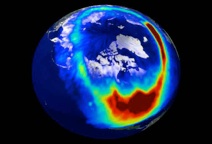
Earth
The Earth's atmosphere may be divided into multiple layers which host different physical processes and thus are, amongst other, characterized by different vertical temperature gradients and gas compositions. The outermost regions, above around 80 km altitude, include the thermosphere and ionosphere, the hottest regions in the Earth's atmosphere with temperatures reaching 1000 K and above. These are the heights where some satellites fly as well as the space shuttle, the International Space Station or until several years ago the MIR space station.
The thermosphere and ionosphere are the boundaries between the Earth's atmosphere and interplanetary space, the solar wind. Solar EUV radiation is absorbed by gases in the thermosphere, primarily Nitrogen and Oxygen, partly ionizing them and forming the ionosphere. Furthermore, this heats the dayside, driving strong winds.
The presence of a magnetic field protects us and our atmosphere from direct exposure to the solar wind, but the atmosphere is affected by electric fields and high energetic particles which are largely driven by the interaction of the magnetosphere with the solar wind. The electric fields map into the high latitude regions, centred around the geomagnetic poles, and generate strong frictional ("Joule-") heating. The incident charged particles generate spectacular auoral lights.
My work tries to examine the complex processes in our upper atmosphere, the coupling with the magnetosphere and how the interplay between the Sun and the magnetosphere as two differently acting driving forces explains many puzzling properties.
In close collaboration with colleagues at the University of Southampton, University College London and Boston University I carry out theoretical studies using one of the most sophisticated global theoretical models currently available worldwide, the Coupled Thermosphere Ionosphere Plasmasphere Model (CTIP), developed over the past quarter century at University College London, the University of Sheffield, the Space Environment Center in Boulder (Colorado) and many other individuals.
Current and recent work has examined the effects of geomagnetic storms on the upper atmosphere (which has important implications for predictions of space weather; the study of long term (annual, semiannual) periodicities in the ionosphere, research into how gases are transported in the upper atmosphere and studies examining the effects of upward propagating tides and planetary waves.
For more information about my work, please see the Publication List or contact me.




